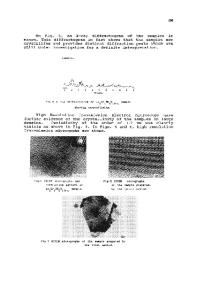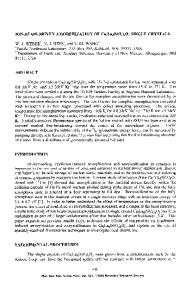Dielectric relaxations, ultrasonic attenuation, and their structure dependence in Sr 4 (La x Nd 1-x ) 2 Ti 4 Nb 6 O 30 t
- PDF / 917,139 Bytes
- 10 Pages / 612 x 792 pts (letter) Page_size
- 46 Downloads / 284 Views
Xiao Guang Li Hefei National Laboratory for Physical Sciences at Microscale, Department of Physics, University of Science and Technology of China, Hefei 230026, China (Received 29 June 2008; accepted 13 August 2008)
The dielectric anomalies and their structure dependence were evaluated and discussed in Sr4(LaxNd1-x)2Ti4Nb6O30 ceramics, together with the analysis of ultrasonic velocity shift and attenuation spectra in the low-temperature range. The room-temperature structure was confirmed as the tetragonal in space group P4bm for all compositions. One diffuse ferroelectric peak and three relaxor ferroelectric peaks corresponding to the commensurate/incommensurate modulation of oxygen octahedra, polar clusters of A-site ion ordering, and B-site ion ordering, respectively, were observed in the composition with x ⳱ 0.25. With decreasing the radius difference between A1- and A2-ions (increasing x), the dielectric relaxations, especially the one originating from the polar clusters of A-site ion ordering, tended to increase significantly and overlap the diffuse ferroelectric peak, which was completely overlapped for x 艌 0.75. This process just reflected the increased disordering degree of both A- and B-site ions, and the analysis of ultrasonic attenuation strongly supported the above conclusions on dielectric relaxations and their structural origins. The ultrasonic attenuation peak at approximately 100 K corresponded to the freezing process of the dielectric relaxations, and the fluctuation with composition of the ultrasonic attenuation peaks between 150 and 260 K suggested the possible structure variation.
I. INTRODUCTION
The studies on the tetragonal tungsten bronze compounds have been intensified not only for their great potential in dielectric and ferroelectric applications1–4 but also for the unique dielectric relaxation behaviors and their physical origins.5–17 Tungsten bronze compounds, known as either ferroelectrics or relaxor ferroelectrics, constitute one of the major families of dielectrics. The tetragonal tungsten bronze structure consists of a complex array of distorted BO6 octahedral, sharing corners in such a way that three types of interstices (pentagonal A1, square A2, and trigonal C) can be occupied by cations and results in the general formula (A1)2(A2)4(C)4(B1)2(B2)8O30. Because the ideal structure for filled tungsten bronze (only the trigonal C site is empty) is tetragonal P4/mbm symmetry with only two
a)
Address all correspondence to this author. e-mail: [email protected] DOI: 10.1557/JMR.2008.0373 3112
http://journals.cambridge.org
J. Mater. Res., Vol. 23, No. 11, Nov 2008 Downloaded: 03 Apr 2015
domain states, the mechanism of the polar reorientation in the tungsten bronze compounds should be significantly different from that in the perovskite compounds.18 Moreover, the interactions among cations are more complicated in tungsten bronze compounds compared with perovskites due to more atom sites in one unit cell. Therefore, it is more difficult to analyze the influences of cation ordering o
Data Loading...











